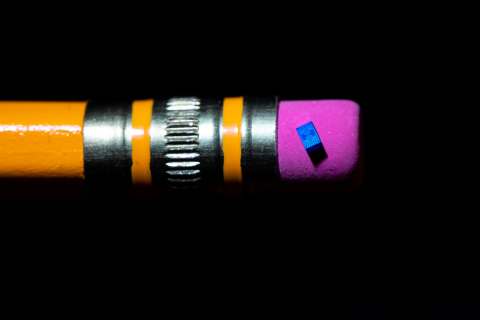HILLSBORO, Ore. — (BUSINESS WIRE) — June 11, 2018 — Intel researchers are taking new steps toward quantum computers by testing a tiny new “spin qubit” chip. The new chip was created in Intel’s D1D Fab in Oregon using the same silicon manufacturing techniques that the company has perfected for creating billions of traditional computer chips. Smaller than a pencil’s eraser, it is the tiniest quantum computing chip Intel has made.
This press release features multimedia. View the full release here: https://www.businesswire.com/news/home/20180611005251/en/

A 2018 photo shows Intel’s new quantum computing chip balanced on a pencil eraser. Researchers started testing this “spin qubit chip” at the extremely low temperatures necessary for quantum computing: about 460 degrees below zero Fahrenheit. Intel projects that qubit-based quantum computers, which operate based on the behaviors of single electrons, could someday be more powerful than today’s supercomputers. (Credit: Walden Kirsch/Intel Corporation)
More: Quantum Computing at Intel | The Future of Quantum Computing is Counted in Qubits (Intel Explainer) | All Intel Images
The new spin qubit chip runs at the extremely low temperatures required for quantum computing: roughly 460 degrees below zero Fahrenheit – 250 times colder than space. The spin qubit chip does not contain transistors – the on/off switches that form the basis of today’s computing devices – but qubits (short for “quantum bits”) that can hold a single electron. The behavior of that single electron, which can be in multiple spin states simultaneously, offers vastly greater computing power than today’s transistors, and is the basis of quantum computing.
The zigzag lines in the photo are printed wires connecting the chip’s qubits to the outside world.
One feature of Intel’s tiny new spin qubit chip is especially promising. Its qubits are extraordinarily small – about 50 nanometers across and visible only under an electron microscope. About 1,500 qubits could fit across the diameter of a single human hair.
This means the design for a new Intel spin qubit chip could be dramatically scaled up. Future quantum computers will contain thousands or even millions of qubits — and will be vastly more powerful than today’s fastest supercomputers.
About Intel
Intel (NASDAQ: INTC) expands the boundaries of technology to make the most amazing experiences possible. Information about Intel can be found at newsroom.intel.com and intel.com.
Intel and the Intel logo are trademarks of Intel Corporation in the United States and other countries.
View source version on businesswire.com: https://www.businesswire.com/news/home/20180611005251/en/
Contact:
Intel Corporation
Stephanie Matthew, 408-218-3636
Email Contact








